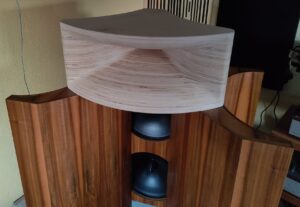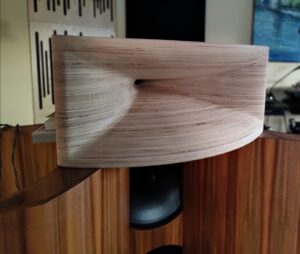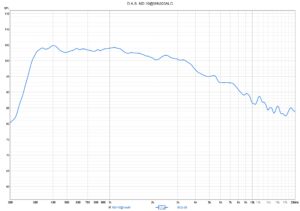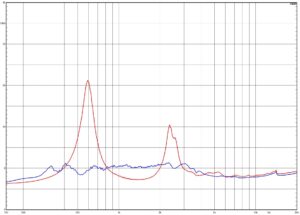In this article I would like to share some measurement results for my new WN300ALO plywood horn. Based on the PLA prototype described here
https://sphericalhorns.net/2022/09/20/acoustic-loading-optimized-william-neile-horns-part-2/
some initial measurements were already done and a preliminary passive crossover network was designed for use in my existing speaker system. This way it was possible to immediately have a listening session when the horns arrived at my home. The measurement results for the PLA horn have not been published because of my concerns about using PLA for such a large horn mainly because of inherent self resonances. And indeed some pronounced and distinct resonances were present in all the measurement data. This has been also verified by spectral analysis when knocking on the horn at different regions. But the results were still good enough for designing a crossover network knowing the problematic resonance frequencies. Maybe it is possible to change the the outer shape of the PLA horn providing better damping. In total contrast to the PLA version the full block plywood version has exceptional good internal damping properties which was one of the main reasons to choose this material and the overall shape of the horn.
Basically it was planned to have a reference setup to compare to so we first listened to the my existing speaker system with 18sound ND3SN@TH4001 fin horn which was my primary choice since a longer time. The TH4001 was a big improvement compared to round Tractrix or any CD horn I tested in my system except for some missing depth of the 3D soundstage. After some songs with the TH4001 in place we mounted the WN300ALO and also changed the readily prepared HF part for the crossover network. What happened with the sound reproduction by switching to the new WN300ALO horn surpassed my highest expectations.
Basically, I expected a more refined sound stage with respect to depth more or less a slight improvement with respect to this. In fact the 3D depth sound stage improved by a large margin to a level that I never imagined before. And what even sounds insane is that the sound representation is much more stable when walking through the room compared to TH4001. Absolutely smooth transitions when walking to the extreme sides of the room or moving the head up and down occurred without noticeable loss of HF. The horizontal dispersion of approx. 60 degrees of the WN300ALO is more than enough for almost every imaginable listening room. Even when rotating the head to the sides everything remained stable. Because the WN300ALO is a best compromise horn it provides full horn loading almost down to the designated cut-off. So the next big very noticeable improvement is a new level of clean and dynamic upper bass and midrange I have never heard before. The WN300ALO is simply by a large margin my new reference horn!
Currently, the new plywood horns get their final finish using a set of traditional violin varnishes. I may write about this in a separate article in the future when the varnish part is finished. After the first long drying period, I took the opportunity to take some frequency response and impedance measurements using a few compression drivers from my stock.
As my personal microphone reference for frequency response measurements the Earthworks M23 was used for this purpose:
For the impedance measurements I generally use CLIO Pocket as a one push button solution.
The first driver investigated was the D.A.S. ND-10 which is a 4″ large format compression driver with a pure titanium diaphragm. Like some JBL drivers it has an uncommon mounting bolt distance of 114mm. But this is no issue with the flexible adapter flange of theWN300ALO:
The horn itself has a 1.4″ throat entry and the ND-10 is a 1.5″ exit driver so I 3D printed an adapter with the same flare rate as the horn but in this case case working effectively reverse as slight compression.
The loading capabilities of the horn are verified by this setup. Loading is almost down to 300Hz maybe even a bit lower. But what is really surprising what we see for the HF part of the frequency response and especially in the last octave above 10k. I have never seen a pure titanium driver that performs like this. Based on these measurements I plan to try this driver in my setup.
Another extreme regarding diaphragm size is the tiny 1.0″ Faital HF108-16. It has a recommended minimum crossover frequency of 1.3kHz. We will see what horn loading is causing to this driver. Of course an adapter is necessary too with the same flare rate as the horn. It has been 3D printed in two parts using a PLA bronze filament and finally glued together:
Just note that the ripple at LF is a comb filter effect of the mic with floor/ceiling. I prefer to measure without damping material and without gating in order to asses the LF capabilities of a driver. Who would have expected that these tiny drivers profit so much from horn loading to about 325Hz? Really amazing how low this driver can put out sound pressure attached to WN300ALO. Although I would not use this driver as low as with the larger format compression drivers and would choose a crossover point above 800Hz or even around 1kHz.
One of my favourite 1.4″ drivers is the 18sound ND3SN which has a nitride coated titanium diaphragm.
We can again observe the comb filter effect with floor/ceiling which is related to the driver/horn. By looking solely at the combined impedance it is hard to guess a sign of the free-air resonance. An almost perfectly damped combined system is the result together with WN300ALO. Furthermore, an almost ideal frequency response decay towards higher frequencies can be observed. Very easy to design a passive crossover for this driver. The current crossover point is slightly below 700Hz which gives more than the traditional rule of thumb to have one octave horn loading for the compression driver below the desired crossover point and this is absolutely safe when the ND3SN is attached to WN300ALO as distortions remain very low down to the cut-off of the horn. I can highly recommend this driver when someone is interested to have a pair of WN300ALO and is unsure what driver to use.
Finally, here are the results for the large format 18sound Beryllium driver ND4015Be. I will definitely re-explore this driver together with WN300ALO in my system. Although the factory adapter 1.5″ to 1.4″ is too short and I plan to 3D print a longer adapter later on which resembles the flare rate of the WN300ALO but already the current results speak for themselves:
In my opinion an almost perfect combined impedance and the frequency response is great if we bear in mind that this is a large format 4″ diaphragm. Together with the WN300ALO it is possible to use the lowest possible crossover point for this driver.
In my opinion it is not necessary to make polar measurements as in a previous article I already demonstrated the very good agreement of the BEM simulations and experimental data:
https://sphericalhorns.net/2022/09/06/acoustic-loading-optimized-william-neile-horns-1in0-prototype/
Additionally, the listening experiences prove the exceptional polar properties of the WN300ALO which define a new reference level for a full acoustic loading horn.
Finally, the WN300ALO horn belongs to the category of authorized prototypes offered by selected partners:
















